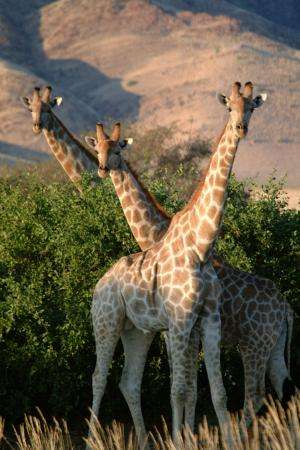Genes offer new insights into the distribution of giraffes

The Giraffe (Giraffa camelopardalis), a symbol of the African savanna and a fixed item on every safari's agenda, is a fascinating animal. However, contrary to many of the continent's other wild animals, these long-necked giants are still rather poorly studied. Based on their markings, distribution and genome, nine subspecies are recognized – including the two subspecies Angola Giraffe (Giraffa c. angolensis) and South African Giraffe (Giraffa c. giraffa).
South African Giraffes occur farther north than previously assumed
Like most other giraffes, these subspecies are now mainly found in nature reserves. Until recently, scientists assumed a clear demarcation of their ranges: Angola Giraffes occur in Namibia and northern Botswana, while South African Giraffes reside in southern Botswana and South Africa. "However, according to our studies, the distribution areas prove to be much more complex. South African Giraffes also occur in northeastern Namibia and northern Botswana, and Angola Giraffes can be found in northwestern Namibia and southern Botswana, as well," explains the study's author, Friederike Bock from the Biodiversity and Climate Research Center (BiK-F). A look at the new distribution map reveals the presence of a population of Angola Giraffes in the Central Kalahari Game Reserve, the world's second-largest national park, quasi nestled between two populations of the South African Giraffe, with both subspecies living side by side.
Subspecies were the result of early geographic separation
According to the research team, the fact that two genetically distinct subspecies could develop within the same region may be explained by the local geographic conditions that prevailed approximately 500,000 to two million years ago. Back then, the mountain range along the East African Rift Valley was sinking, creating vast wetlands and lakes, such as the paleo lake Makgadikgadi. According to Professor Dr. Axel Janke from the BiK-F, "these large bodies of water may have separated the populations for long periods of time. Moreover, female giraffes likely do not migrate across long distances, thereby contributing to a clear separation of the maternal lines." Today, there no longer exist any barriers that prevent the possible mingling of both subspecies; an investigation of these processes is however subject to further genetic analyses.
Angola and South African Giraffes can be uniquely identified by their maternal gene profile
For the study, the researchers created a profile of the subspecies' mitochondrial DNA, using tissue samples from about 160 giraffes from various populations across the entire African continent. On the basis of this genetic material, inherited from the maternal side, the often similarly marked subspecies can be uniquely identified genetically and the relationships between various populations can be clearly demonstrated. "Our focus was on giraffes in southern Africa, in particular in Botswana and South Africa. There, we sampled populations that had not been genetically analyzed before," says Bock.
New insights enable improved protection measures for the giraffe
According to estimates by the World Conservation Organization IUCN, the world's giraffe population is about 100,000 individuals – showing a decreasing trend. In Botswana alone, the population has dwindled by more than half in recent years. In order to achieve effective protection measures that will preserve the majority of the giraffe's subspecies, it is indispensable to gain knowledge that allows their reliable identification as well as detailed information regarding their distribution. The surprising results concerning the distribution of the two subspecies in Namibia and Botswana emphasize the importance of additional taxonomic research on all giraffe subspecies.
More information: Bock, F. et al. (2014):" Mitochondrial sequences reveal a clear separation between Angolan and South African giraffe aLlong a cryptic rift valley" - BMC Evolutionary Biology, DOI: 10.1186/s12862-014-0219-7
Journal information: BMC Evolutionary Biology



















